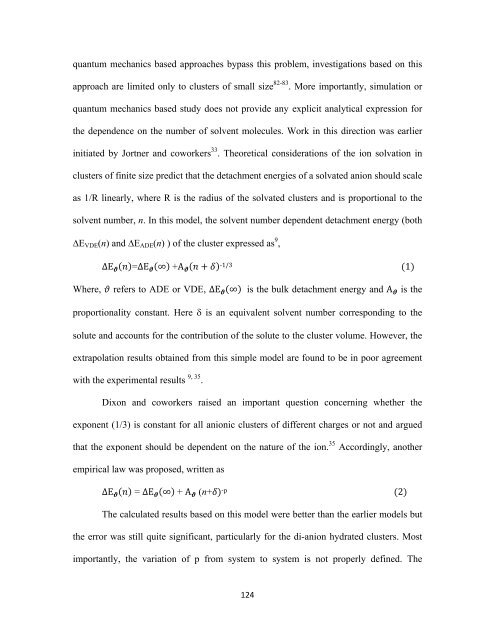CHEM01200604005 A. K. Pathak - Homi Bhabha National Institute
CHEM01200604005 A. K. Pathak - Homi Bhabha National Institute
CHEM01200604005 A. K. Pathak - Homi Bhabha National Institute
You also want an ePaper? Increase the reach of your titles
YUMPU automatically turns print PDFs into web optimized ePapers that Google loves.
quantum mechanics based approaches bypass this problem, investigations based on this<br />
approach are limited only to clusters of small size 82-83 . More importantly, simulation or<br />
quantum mechanics based study does not provide any explicit analytical expression for<br />
the dependence on the number of solvent molecules. Work in this direction was earlier<br />
initiated by Jortner and coworkers 33 . Theoretical considerations of the ion solvation in<br />
clusters of finite size predict that the detachment energies of a solvated anion should scale<br />
as 1/R linearly, where R is the radius of the solvated clusters and is proportional to the<br />
solvent number, n. In this model, the solvent number dependent detachment energy (both<br />
ΔE VDE (n) and ΔE ADE (n) ) of the cluster expressed as 9 ,<br />
∆E =∆E ∞ +A ‐1/3<br />
1<br />
Where, refers to ADE or VDE, ∆E ∞ is the bulk detachment energy and A is the<br />
proportionality constant. Here δ is an equivalent solvent number corresponding to the<br />
solute and accounts for the contribution of the solute to the cluster volume. However, the<br />
extrapolation results obtained from this simple model are found to be in poor agreement<br />
with the experimental results 9, 35 .<br />
Dixon and coworkers raised an important question concerning whether the<br />
exponent (1/3) is constant for all anionic clusters of different charges or not and argued<br />
that the exponent should be dependent on the nature of the ion. 35 Accordingly, another<br />
empirical law was proposed, written as<br />
∆E = ∆E ∞ + A (n+ ‐p<br />
2<br />
The calculated results based on this model were better than the earlier models but<br />
the error was still quite significant, particularly for the di-anion hydrated clusters. Most<br />
importantly, the variation of p from system to system is not properly defined. The<br />
124
















